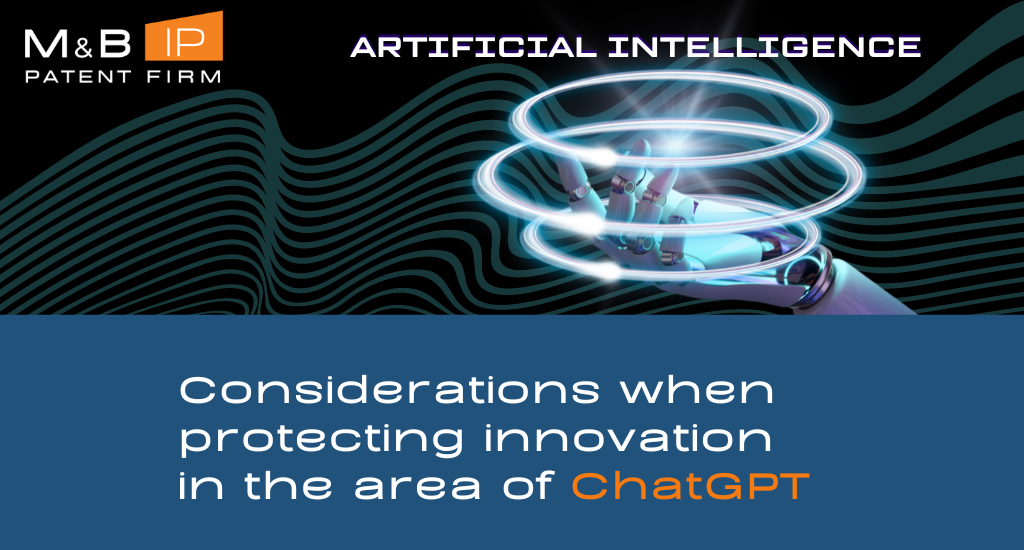- April 30, 2023
- Posted by: mbipuser
- Categories: Ip Topics, Latest article

Considerations when developing and protecting innovation in the area of ChatGPT
“The Age of AI has begun.” Microsoft co-founder Bill Gates seems to think that the introduction of OpenAI’s artificial intelligence (AI) chatbot, ChatGPT, heralds a new age of AI-based innovation. Many people, including Gates, are thinking about how the technology behind AI systems like ChatGPT could be used to improve almost every facet of modern life, signaling a belief that we are entering a new revolutionary age of tech.
With such lofty expectations, it’s no wonder that tech leaders are looking to get further into the AI game. Like many other trends in technology recently, there seems to be a gold rush of companies looking to invest in AI technologies like the kinds of Large Language Model (LLM) used to power ChatGPT. A LLM is a language model, which is a type of model used to make predictions related to computational linguistics. LLMs have neural networks, a machine learning system designed to mimic how a brain works. Neural networks are trained on as many as billions of parameters.
The advent of ChatGPT and the increased attention on LLMs has also created a lot of interest in patenting AI solutions. While everyone seems to want to get a piece of the patent space on LLMs now, only some of these innovations will ultimately obtain granted patents. Here at M&B IP, we have some general thoughts about patenting LLM solutions which might help you think about which innovations might be good candidates for patenting.
When patenting any solution based on existing technology, a key consideration is how the solution improves upon the technology that came before it. For software patents like those based on artificial intelligence software, the patent laws generally improve solutions that provide technical improvements to the existing solutions. In the case of solutions related to ChatGPT, the underlying type of model (LLMs) already exists. Simply using ChatGPT for a new use case likely would not be considered an improvement on the technology. So we usually need to look deeper.
In general, the question to ask instead of “what are we using LLMs for?” is something like “how are we using LLMs in a new way?” Areas where there could be changes to how the LLM is being used may relate to tokenization, embedding, cross-domain applications, and combining LLMs with other models. Some particular questions to consider include:
- Is there a new tokenization process?
- Were choices made based on tokenization costs?
- Is the input query optimized?
- Is input query size limited? Why/how?
- Is there a new embedding technique?
- How are you improving embedding?
- Why did you pick a specific embedding technique/scheme?
- Are you applying a solution to a problem in one domain to a problem in another domain?
- Are you using any other models, particularly machine learning models, together with a LLM?
These and other questions might help you identify aspects of your new LLM solution which could be good candidates for patenting because these questions would assist in demonstrating innovative concepts and technical improvement requirements according to the current state of the law, particularly 35 USC §101.
However, these are not the only issues to consider when protecting patents related to generative AI. Another major question in the patent world relates to inventorship. What happens if you ask ChatGPT to give you an algorithm by telling it a problem and giving it some guidelines or requirements for the process. Unfortunately in this case, since the AI model learns and creates new algorithms for processing, the AI would arguably be the sole inventor of a new algorithm. Further, if a human inventor utilizes ChatGPT to expand on an idea and features provided by ChatGPT are claimed, there could be a substantial question of inventorship.
The United States Patent Act defines an inventor as an “individual.”[1] Generally speaking, “individual” has been interpreted as a human person. When Stephen Thaler tried to register a patent created by his AI, the United States Patent and Trademark Office denied his patent. Thaler has since gone through every step of the legal process and recently petitioned the US Supreme Court to review a decision by the United States Court of Appeals for the Federal Circuit regarding whether an AI system can be an individual.
In August 2022, the Court of Appeals for the Federal Circuit held that the US Patent Act requires inventors listed on patent applications to be natural persons. The Court of Appeals additionally held that AI could not be the named inventor or the sole inventor. This ruling affirmed the Eastern District of Virginia’s holding that an inventor must be a “natural person.” Additionally, the United States Patent and Trademark Office (USPTO) denied these AI developed patents that had the AI listed as the sole inventor.
The United States is not the only country where Thaler has applied for patent protection in the name of his AI system. An almost identical case is scheduled to appear in front of the United Kingdom’s Supreme Court. His patent applications with the AI listed as the inventor were also rejected in the European Union, Australia, and Germany. However, South Africa permitted the invention listing the AI as an inventor.
On April 25, 2023, the Supreme Court denied certiorari in the case of Thaler v. Vidal and, as a result, will not hear the case. Currently, the USPTO is accepting public comments regarding AI and inventorship.
Additional issues in using AI to develop intellectual property (IP) relate to disclosure. Going back to the example above, an inventor seeking to expand their innovation through ChatGPT may enter confidential information as a prompt. Although untested in court, this could be considered to be disclosing confidential information because ChatGPT retains user input data for machine learning to train itself. As recently reported, Samsung experienced instances of company-secret leaks involving ChatGPT. In one instance, engineers prompted ChatGPT with source code information into ChatGPT to fix and optimize the code, inadvertently disclosing confidential Samsung information to OpenAI.
With the issues and risks mentioned above, patenting an AI innovation can bring several benefits to the innovators and the companies that develop them. Overall, patenting AI innovation can provide significant benefits to innovators and companies, including legal protection, increased value, innovation incentives, and enhanced reputation. that would make bold moves to protect their AI innovation will win the AI race.
About M&B IP
M&B IP is a patent firm founded with the mission to maximize start-ups’ valuations through patent portfolio development. Our patent portfolio methods have been trusted by the founders of Twistlock, Armis, Radware, Adallom, and many more.
